State of the Economy and Markets, Bearish on Most Things Except Gold
Stock-Markets / Financial Markets 2009 Aug 02, 2009 - 10:25 AM GMT There were quite a few economic reports out this week and many of them are starting to slowly turn more positive. This is good news, as a journey of 1000 miles begins one step at a time. However, much of what is reported in the media tends to have a spin put on it. I want the economy to improve as much as the next person, but I want to know if it’s for real or not, as in sustainable.
There were quite a few economic reports out this week and many of them are starting to slowly turn more positive. This is good news, as a journey of 1000 miles begins one step at a time. However, much of what is reported in the media tends to have a spin put on it. I want the economy to improve as much as the next person, but I want to know if it’s for real or not, as in sustainable.
The purpose of these reports is to provide information on a weekly basis to keep subscribers updated as to what is going on in the economy and the markets. I try to tell it like it is, as opposed to saying what the reader might want to hear. I try not to put any spin on the report, but I admit to being bearish on most “things” except gold and a few other commodities. That is my interpretation of the state of both the economy and the markets, and the faulty monetary system they are built upon. As we go through the following economic reports and data I will play the devil’s advocate by looking deeper for what might be wrong, as opposed to just reading surface reflections. The proof is in the details as they say.
New home sales jumped 11% in June to an annual rate of 384,000. The month-to-month percentage change is the highest in nearly 9 years. However, it must be noted that an 11% increase from historic lows, is not the same thing as an 11% increase from “average” or “normal” sales levels.
As the chart below shows, new home sales have fallen off a cliff, and have barely budged up. That sales are increasing is good news, but it must be viewed in the proper perspective. Hopefully, sales will continue to grow, but as the chart shows, to get back to any semblance of “average” or “normal” levels, a lot of improvement needs to occur.
To expand to 600,000 units will take a 50% increase; to expand to 800,000 units will require a doubling in sales. This is a perfect example of the ravages a bear market inflicts. Gains of 10-20% off the lows are very small gains after losses of 71% from the highs (see housing charts in stock section).
The median price fell 5.8% to $206,200 for the month, which helped sales to rise. The yearly price change fell to minus -12%from May's minus -4.5 percent; showing that prices are falling in an attempt to find the right level to rebalance the market.
It must be remembered that lower prices mean an increase in negative equity value, which in turn will most likely mean more foreclosures.
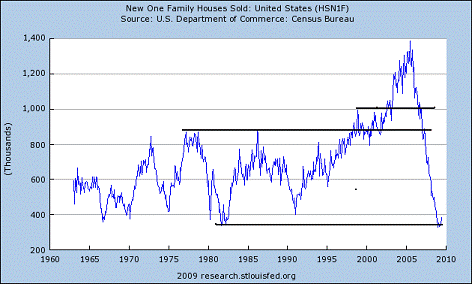
Durable goods orders fell 2.5% in June. Year over year new orders are down to minus -26.8%, not a good reading. The drop in new orders was led by transportation, down 12.8 percent.
Nondefense aircraft fell 38.5 percent, defense aircraft jumped 30.1%, and motor vehicles slipped 1.0 percent.
I’ve highlighted the defense aircraft number because it is evidence of the fact that a lot of the recent good news or data is a direct result of an increase in government spending, which is not a good thing.
The government can only raise money by taxing the people or by selling more debt (treasury bonds), neither of which creates wealth. At best, all such actions only redistribute wealth, and it is easily arguable that such action destroys wealth.
An increase in debt can go by no other name. The chart below is for new nondefense capital goods excluding aircraft, and it is not a pretty chart. Perhaps a low is being made, perhaps it isn’t. Time will tell.
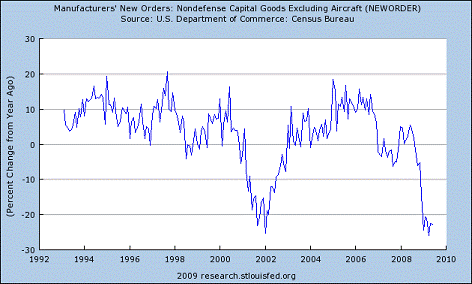
The Labor Department reported that first-time jobless claims increased 25,000 to 584,000. The prior week was revised higher (5,000) to 559,000. Continuing claims fell 54,000 to 6.19 million.
The unemployment rate for insured workers was unchanged at 4.7%. Until unemployment decreases steadily, the consumer will be hard pressed, and so too the economy.
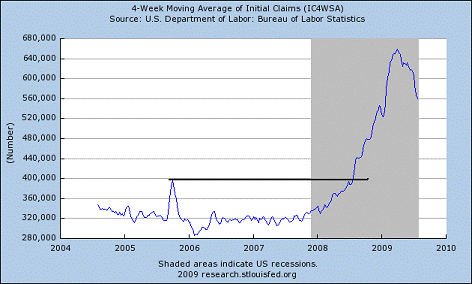
The Bureau of Economic Analysis reported that real gross domestic product (GDP) declined 1.0% in the second quarter of 2009 after declining 6.4% in the first quarter.
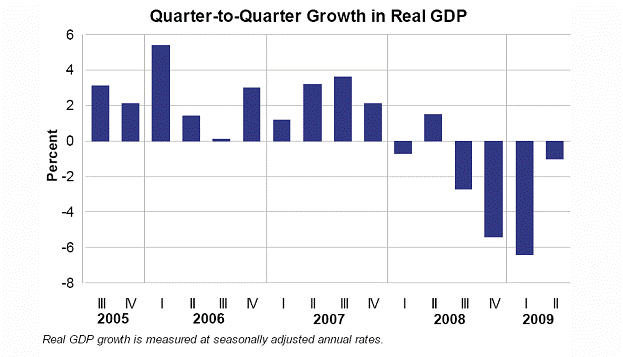
Gross domestic product
The smaller decrease in real GDP reflected:
- Much smaller decreases in business investment, including inventory investment, and in exports
- An upturn in government spending
- A smaller decline in housing
Offsetting these movements:
- A downturn in consumer spending
- A smaller decline in imports
The big negative was a drop in personal consumption. It is a tough call to say the economy is improving if the consumer is not spending, as the consumer accounts for 70% of the economy. Evidence the chart below showing the huge fall in consumer spending.
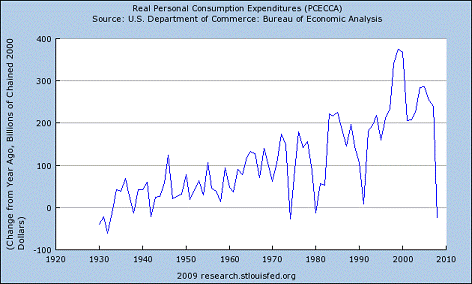
Likewise, it is tough for the consumer to spend that which they do not have, as evidenced by the chart below of disposable income, followed by a chart of personal savings that rose (as a percent of disposable income) 5.2% from the previous month’s reading of 4%.
The increased savings rate is a very good thing, as it represents wealth accumulation and eventually pent up demand that will one day be spent – the question is when and how much of it?
Personally, the only positive I see is the savings rate increase. This is exactly what needs to take place, but it is a first step, and without a sound monetary system, it will be hard to build upon, which is why Congressman Ron Paul’s call to abolish the Fed and return to gold and silver coin as mandated by the Constitution is imperative.
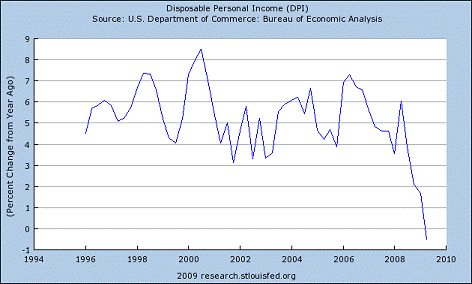
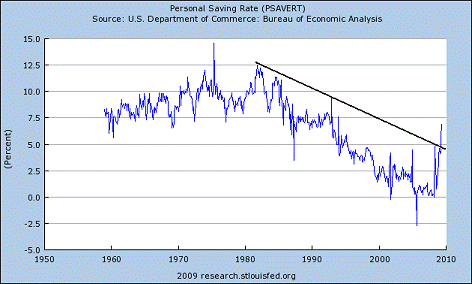
Lastly, note the following long term charts of Gross Domestic Product (GDP), which tell a bit of a different story than the quarterly chart at the beginning of this section.
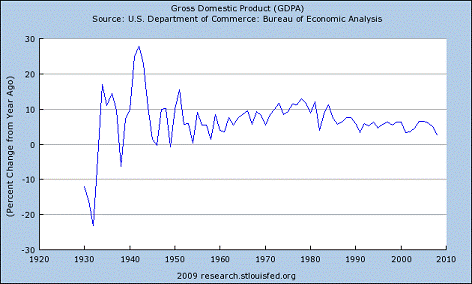
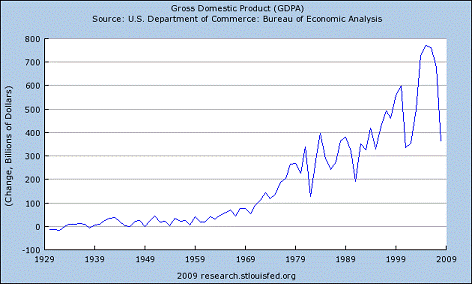
Stocks
The stock market continues to forge ahead, but the gains were smaller and volume is declining. The S&P was up just under 1% for the week, adding on 8.22 pts to close at 987.48.
It appears that the 1000 level is providing formable resistance as it goes back to Nov. 2008 (see chart below).
RSI and CCI are in overbought territory and have turned down. We have seen, however, that markets can stay overbought for extended periods of time.
I continue to believe that now is not the time to chase after stocks; the rally is much closer to its end than its beginning.

Next up is a chart of the financials. It too, shows resistance going back into 2008. Notice that it has not yet been able to close above its May high.

Below is the bank index, which shows resistance going back to the start of 2009. Also notice that it too is well below its May high.
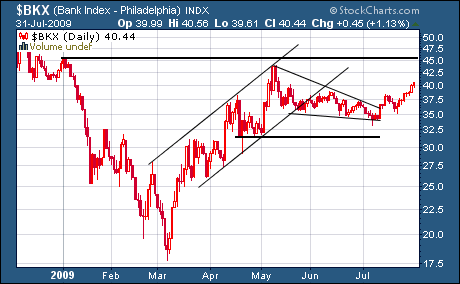
Earlier in the report new home sales were shown to be improving, but still far below any semblance of “normal” levels. Below are a couple of charts of the housing index, which tell the same tale.
The first chart shows the strong rally off the May lows that is bumping up into its 50% retracement level from the Oct. 2008 high.
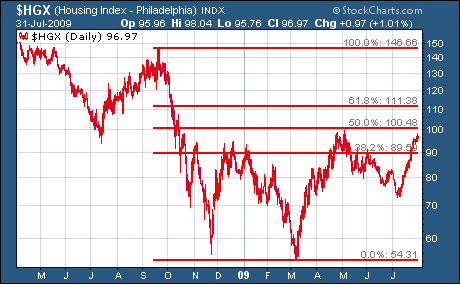
The next chart below shows the housing index falling 81% from the 2005 high of 283 to the 2009 low at 54.
Now, the index is still below 100 or 183 points from its high, meaning it would have to double from here to get back to even.
The banking sector has performed about the same. Green sprouts – maybe. We’ll see soon enough.
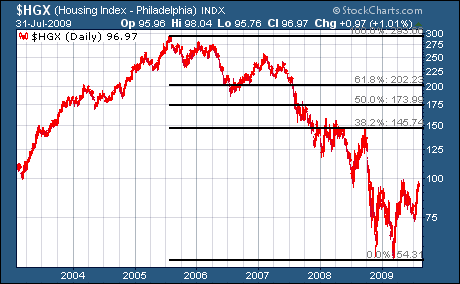
The above excerpt is a small sampling from the latest full-length version (36 pgs) of this week’s market wrap report, available only at the Honest Money Gold & Silver Report website. All major markets are covered with the emphasis on the precious metals, commodities, and currencies.
The markets are at important inflection points and there will be some big winners and losers just ahead. A free trial subscription is available by submitting a request to: dvg6@comcast.net.
Stop by and check out the myriad forms of information available, not only on investing, but on the history of gold and silver money as mandated by the U.S. Constitution, which is the answer to the present financial crisis and one’s own personal protection and freedom from the loss of purchasing power caused by paper fiat debt-money (Federal Reserve Notes or paper dollar bills).
Good luck. Good trading. Good health, and that’s a wrap.

Come visit our website: Honest Money Gold & Silver Report
New Book Now Available - Honest Money
Douglas V. Gnazzo
Honest Money Gold & Silver Report
About the author: Douglas V. Gnazzo writes for numerous websites and his work appears both here and abroad. Mr. Gnazzo is a listed scholar for the Foundation for the Advancement of Monetary Education (FAME).
Disclaimer: The contents of this article represent the opinions of Douglas V. Gnazzo. Nothing contained herein is intended as investment advice or recommendations for specific investment decisions, and you should not rely on it as such. Douglas V. Gnazzo is not a registered investment advisor. Information and analysis above are derived from sources and using methods believed to be reliable, but Douglas. V. Gnazzo cannot accept responsibility for any trading losses you may incur as a result of your reliance on this analysis and will not be held liable for the consequence of reliance upon any opinion or statement contained herein or any omission. Individuals should consult with their broker and personal financial advisors before engaging in any trading activities. Do your own due diligence regarding personal investment decisions. This article may contain information that is confidential and/or protected by law. The purpose of this article is intended to be used as an educational discussion of the issues involved. Douglas V. Gnazzo is not a lawyer or a legal scholar. Information and analysis derived from the quoted sources are believed to be reliable and are offered in good faith. Only a highly trained and certified and registered legal professional should be regarded as an authority on the issues involved; and all those seeking such an authoritative opinion should do their own due diligence and seek out the advice of a legal professional. Lastly Douglas V. Gnazzo believes that The United States of America is the greatest country on Earth, but that it can yet become greater. This article is written to help facilitate that greater becoming. God Bless America.
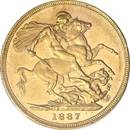
Douglas V. Gnazzo © 2009 All Rights Reserved
© 2005-2022 http://www.MarketOracle.co.uk - The Market Oracle is a FREE Daily Financial Markets Analysis & Forecasting online publication.



